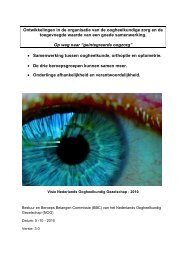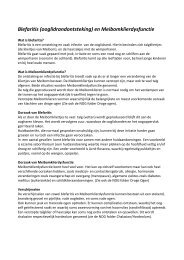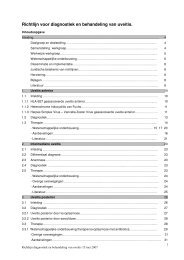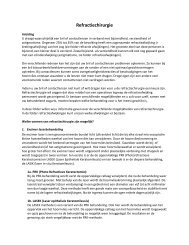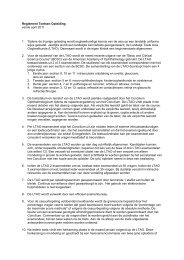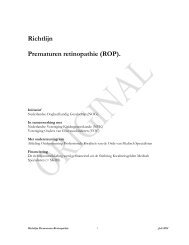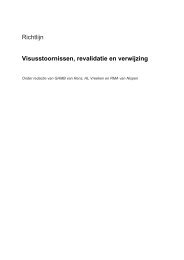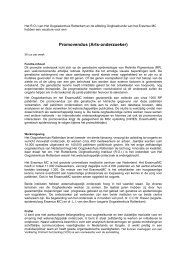terminology and guidelines for glaucoma ii - Kwaliteitskoepel
terminology and guidelines for glaucoma ii - Kwaliteitskoepel
terminology and guidelines for glaucoma ii - Kwaliteitskoepel
Create successful ePaper yourself
Turn your PDF publications into a flip-book with our unique Google optimized e-Paper software.
3.2 - TARGET IOP AND QUALITY OF LIFE<br />
3.2.1 - THE TARGET INTRAOCULARPRESSURE (TARGETIOP)<br />
Definition: an estimate of the mean IOP obtained with treatment that is expected to prevent further <strong>glaucoma</strong>tous<br />
damage. It is obviously difficult to assess accurately <strong>and</strong> in advance the IOP level at which further damage may occur<br />
in each individual patient <strong>and</strong> individual eye (see Ch. Introduction II). There is no single IOP level that is safe <strong>for</strong><br />
every patient. However, it is generally assumed in <strong>glaucoma</strong> that aiming to achieve at least a 20% reduction from the<br />
initial pressure at which damage occurred or in advanced <strong>glaucoma</strong> to lower the IOP to a level below 18 mmHg at all<br />
visits is a useful way to achieve the initial target IOP 14 . In individuals with elevated IOP between 24 mm Hg <strong>and</strong> 32<br />
mm Hg in one eye <strong>and</strong> between 21 mm Hg <strong>and</strong> 32 mm Hg in the other eye, topical ocular hypotensive medication<br />
was effective in delaying or preventing the onset of POAG when the IOP was reduced by 20% or an IOP of 24 mm<br />
Hg or less was reached 15 . This does not imply however that all patients with borderline or elevated IOP should receive<br />
medication. A study comparing treatment vs no treatment in early <strong>glaucoma</strong> 16-17 showed that lowering the IOP by<br />
25% from baseline determined a 45% decrease in the risk of progression. Patients with POAG with baseline pressures<br />
below 30 mm Hg could have a management plan that allows initial observation be<strong>for</strong>e treatment to assess the rate of<br />
change 16,17 (see Ch. Introduction II). Such an approach is different from the Target Pressure oriented initial approach<br />
to POAG <strong>and</strong> presupposes a monitoring system that allows recognition of change.<br />
The least amount of medication <strong>and</strong> side effects to achieve the therapeutic response should be a consistent goal<br />
(see FC VI).<br />
The target IOP varies according to:<br />
• IOP level be<strong>for</strong>e treatment<br />
• The overall risk of IOP-related optic nerve damage, which depends on<br />
* average IOP<br />
* maximum IOP<br />
* fluctuations of IOP<br />
In case of doubt, consider per<strong>for</strong>ming 24 hour or diurnal phasing to identify IOP spikes<br />
• Stage of <strong>glaucoma</strong><br />
The greater the pre-existing <strong>glaucoma</strong> damage, the lower the target IOP should be.<br />
In eyes with severe pre-existing damage, any further damage may be functionally important.<br />
• Rate of Progression (RoP) of <strong>glaucoma</strong>tous damage<br />
Progressive damage is more likely with higher IOP, more severe pre-existing damage <strong>and</strong> more risk factors.<br />
• Age of patient<br />
• Life expectancy of patient<br />
• Presence of other risk factors<br />
A lower IOP may be needed if other risk factors are present<br />
Target IOP may need adjustment during the course of the disease<br />
Periodic re-evaluation of individual target IOP considering:<br />
* Efficacy<br />
* Cost vs benefits<br />
If the visual field continues to worsen at a rate that is clinically significant, it may be necessary to aim <strong>for</strong> a lower target<br />
IOP. With the re-evaluation it is important to exclude other risk factors, such as systemic hypotension, poor<br />
compliance or IOP spikes 12-22 .<br />
Although some benefit can be derived from lowering the IOP even if the target pressure is not reached, the efficacy<br />
on the outcome must be assessed carefully in each individual.<br />
Un<strong>for</strong>tunately one of the limitations of the target IOP approach is that we only know with hindsight whether the target<br />
pressure selected initially was adequate or not. In other words a patient must get worse be<strong>for</strong>e we verify that the<br />
target pressure was inadequate.<br />
Ch. 3 - 5 EGS



